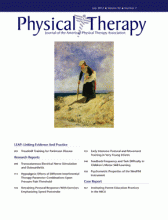Abstract
Background Postural responses are impaired after stroke, with reduced or delayed muscle activity in the paretic leg muscles.
Objective The efficacy of exercises emphasizing speed of movement in modifying postural responses to perturbations that were not practiced was investigated.
Design This was a dual cohort design.
Methods A convenience sample of 32 individuals with hemiparesis poststroke (mean number of weeks poststroke=11.3, SD=4.1) who were recruited upon discharge from an inpatient rehabilitation hospital and a control group of age- and sex-matched individuals who were healthy (n=32) performed a single session of exercise emphasizing speed of movement. To assess postural responses to internal perturbation, unilateral arm raise and load drop tasks were performed before exercises (pre-exercise), immediately after exercises (post-exercise), and 15 minutes after exercises (retention). The time to burst peak and area of the biceps femoris muscle (BF) electromyographic (EMG) activity in the arm raise task was measured with the arm acceleration and velocity of the center of pressure (COP) excursion. For the load drop task, the anticipatory EMG deactivation area of the BF was calculated. In both tasks, the vertical ground reaction forces were recorded for each leg separately.
Results Before exercise, EMG and force platform measures were smaller in the stroke group than in the control group. After exercise, the paretic BF time to burst peak decreased, the paretic BF EMG area increased, and the COP velocity increased in the arm raise task, as did the paretic BF anticipatory EMG deactivation area in the load drop task. The stroke group was weight bearing more symmetrically after exercises. Most changes were retained 15 minutes after the exercises.
Limitations The retention period was short, and there was no control group of individuals with stroke.
Conclusions The results of this efficacy study demonstrated that fast movement exercises improved postural responses to perturbations that were not practiced.
Footnotes
Dr Garland provided concept/idea/research design, fund procurement, facilities/equipment, and institutional liaisons. Dr Gray and Dr Garland provided writing. Dr Gray, Dr Ivanova, and Dr Garland provided data collection. Dr Gray, Dr Juren, and Dr Ivanova provided data analysis. Dr Ivanova provided project management. Dr Juren provided consultation (including review of manuscript before submission.
The Heart and Stroke Foundation of Ontario (grant no. HSFO NA5585) provided financial support.
- Received November 24, 2011.
- Accepted March 4, 2012.












